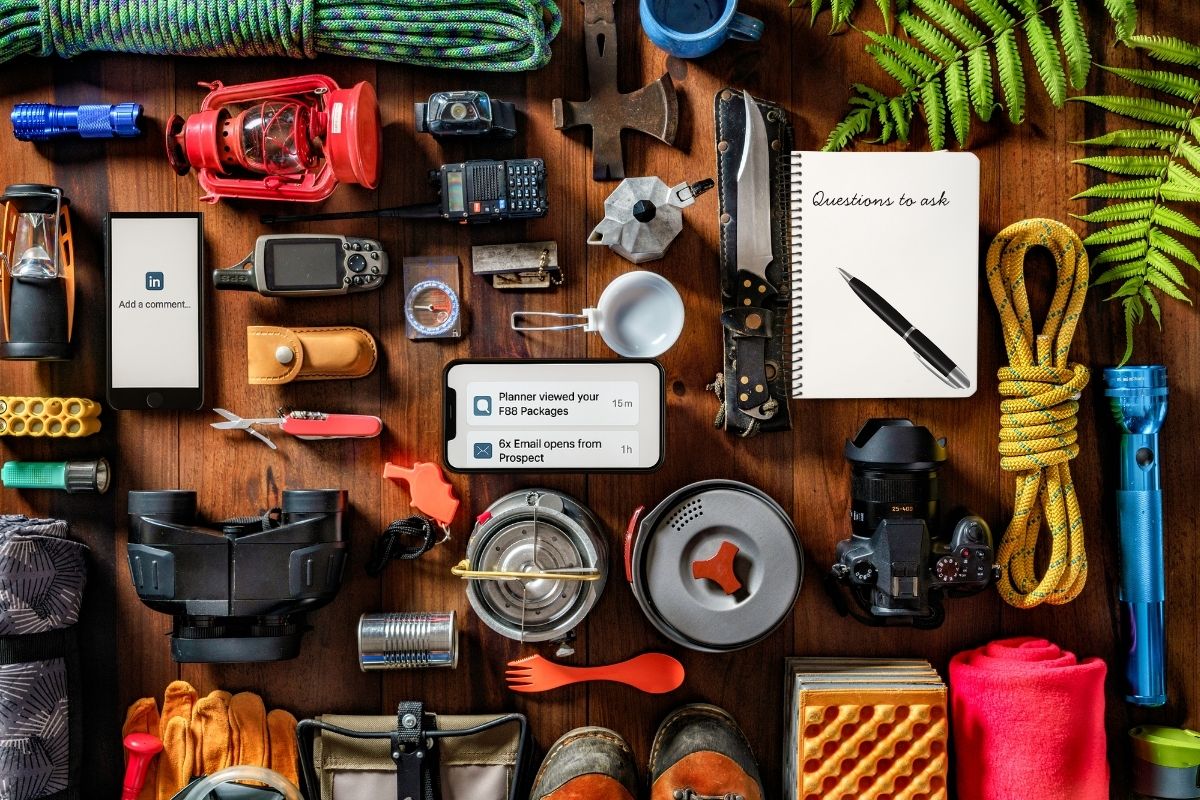
Why the “check-in and circle back” era of hotel sales is officially over
The inbox dings again.
Another “Just checking in!” email is sent into the void, joining hundreds like it … unread, unreturned, and unremarkable.
Down the hall, a sales manager dials through their “follow-up Friday” list, repeating the same script they’ve used since 2018. The results? Crickets.
For hotel sales teams across the country, the old playbook has stopped working. RFPs are drying up, inbound leads have slowed to a trickle, and the buyers they’re chasing are finding venues in entirely new ways, often without ever speaking to a sales rep.
That’s where Sales on Tap Co-Founder and Gap Selling Certified Training Partner, Celeste Berke Knisely, comes in.
She recently sat down with my partner Cory Falter on The InnSync Show to talk about something we’ve been yelling from the rooftops (and rooftops bars) for months now: the way hotel sellers are prospecting is broken.
What worked five years ago isn’t just outdated. It’s irrelevant.
Cory and Celeste have one of those energetic, high-voltage dynamics that makes you lean in and want to take notes. And lucky for you, I did.
Here are the big takeaways from their conversation and what the top hotel sales teams already know (and do) that the rest are still catching up to.
Hotel Sales Prospecting Tips
1. Top Sellers Stop Talking About the Ballroom
Features are a dime a dozen. Ballrooms, breakout rooms, room blocks, and rooftop bars.
Guess what? Your comp set has most of those, too.
Leading with features doesn’t differentiate you; it commoditizes you.
Instead of rattling off capacity charts and F&B minimums, top sellers ask better questions. They get curious about what the planner is trying to achieve and not just what size room they need.
Cory said, “The difference between selling empty space versus handholding someone through an experience is crucial for success.”
And Celeste added this analogy: “Imagine walking into a shoe store, not sure what you need. One salesperson hands you three styles in your size. The other asks about your foot type, injury history, and what you’ll be using them for.”
Who would you trust more?
It’s the same in hotel sales. The best sellers are flipping the script. Instead of saying, “Here’s what we have,” they’re asking, “Why is this meeting important? What does success look like for you? What are you worried about?”
That kind of conversation builds trust, and helps you move from order taker to trusted advisor.
2. RFPs Will Soon Be the Fax Machine
Ouch.
But let’s be honest … someone had to say it.
RFPs used to be the golden goose. Now? They’re a bottleneck. They’re clunky, slow, and almost entirely void of buyer context.
These days, folks are leaning into instant research, AI shortcuts, and buyer autonomy; the RFP is often the last stop if you’re lucky enough to even get there.
Cory said, “The whole purpose of agentic search and AI is to dissolve intermediaries. Buyers are sourcing venues directly—no RFP, no CVENT, no middleman.”
Modern planners are skipping the traditional process entirely. They’re going straight to Google. Or ChatGPT. Or social. They’re finding venues, qualifying them in five minutes, and you may never know they were even looking.
Celeste added, “There are buyers actually searching for you, but you didn’t make the shortlist. Why? Because you weren’t visible. You didn’t show value. You didn’t show up.”
Even worse? Most hotels are still over-investing time and energy in low-win-rate RFPs. If your close rate on those is hovering around 3%–5%, why are they still your sales team’s primary focus?
Instead of chasing every generic lead, top sellers are doubling down on visibility, positioning, and relevance, so when that buyer starts searching, they show up.
And when that inquiry hits the inbox? It’s not treated like one of 50. It’s prioritized and personalized, because that’s where the win is.
3. Direct Inquiries Are Gold, But Most Sellers Miss Them
If you’ve been selling long enough, you’ve seen it happen: an email drops in from your hotel’s website contact form. It’s not a professional meeting planner—it’s someone in marketing, HR, or operations. They’re asking about availability for a team offsite or regional sales meeting.
No RFP. No intermediary. Just one question: “Do you have space?”
Most salespeople don’t realize that these direct inquiries are the warmest leads they’ll ever get. This person didn’t stumble into your inbox by accident. They found you, picked you, and are quietly hoping you’ll make their life easier.
Cory and I see this every week in our work with hotels.
In this episode, he said, “When someone reaches out directly, it means there’s intent. You’re not competing with 27 other hotels. You’re on their mind for a reason. That is not the time to ghost them—or worse, make them wait four days for a response.”
Celeste shared a painful story that proves the point. A planner reached out to her in frustration, saying she couldn’t get a response from a hotel in Denver. Celeste messaged the DOS directly on LinkedIn. The reply? “I’m on vacation. I’ll get back to you next week.”
By then, the planner had already booked elsewhere.
The worst part? It happens all the time. Not because sellers don’t care, but because they’re overloaded, under-prioritizing, or treating direct inquiries like just another lead.
They’re not. These buyers are telling you with their actions:
I found you. I want to work with you. Please make this easy.
Top sellers know to roll out the red carpet the minute that email hits. Because if you don’t? Someone else will.
4. Warm Prospecting Wins (Especially in Flip-Flops)
This might be my favorite part of the entire conversation.
Cory coined a term I wish I’d come up with: warm prospecting, a method that aligns perfectly with how buyers behave today.
Instead of cold outreach that screams “I need you to buy from me,” warm prospecting is rooted in relevance, timing, and trust-building.
It works like this:
- Your hotel sends out monthly value-driven content (trends, tips, planning ideas and not promos).
- A prospect clicks through and lands on your website.
- You get notified they visited (yes, the tech exists), and you see what they looked at; maybe your team page, F&B packages, or a recent blog post.
- Then you reach out—not cold, not random, but with context.
This isn’t theoretical. We’ve been doing this for our clients for years.
Cory shared an actual story from one of our hotels. A planner had been in the CRM for three years, received 56 pieces of content, never responded once, and then booked six figures of business.
No RFP. No back-and-forth. They felt connected. They gained trust.
Why? Because of consistent, helpful, human communication.
5. LinkedIn Isn’t Optional Anymore
The days of hiding behind your brand are over. People don’t want to work with a building; they want to work with a person.
That’s why Celeste challenged sellers to treat themselves like entrepreneurs:
She said, “What’s your quarterly plan to show up online? What are you talking about? Where are you showing up? If the only thing you’re posting is a photo of your lobby renovation or a coffee cup on your rooftop bar…you’re missing it.”
Cory echoed it, too.
Sellers who consistently engage on LinkedIn by leaving thoughtful comments, posting helpful takes, and starting conversations are the ones who get remembered.
Even if someone doesn’t engage, they’re watching. And when the time comes, guess who pops into their head?
6. One-and-Done Training is a Waste of Money
This is where Celeste went full sales scientist, and I loved it.
She brought up the Ebbinghaus Forgetting Curve, which shows that after just 7 days, most people forget 70% of what they learn if they don’t apply it. In other words, your annual training event is probably just a very expensive happy hour.
That’s why we created Sales on Tap: to make sales training ongoing, relevant, and actually useful in real time.
“Learning isn’t a one-time dopamine hit,” Celeste said. “It’s reps. It’s getting messy. It’s building new muscle memory over time.”
7. The Most Successful Sellers Act Like They Own the Business
If I had to sum up the biggest mindset shift hotel sellers need to make, it’s this: stop waiting, start building.
Cory and Celeste both hit this point hard. Whether it’s prospecting, posting, following up, or asking better questions—top sellers aren’t checking boxes. They’re thinking like business owners.
“We’ve got to stop thinking of prospecting as just sales activity,” Celeste says. “It’s not about blasting out brochures or asking if they have any upcoming meetings. It’s about being a helper. A guide. A strategic partner.”
Because guess what? If you’re not showing up as a trusted advisor, someone else will.
Final Thoughts (aka A Loving Nudge)
If you’re a sales leader reading this, here’s my honest take:
- The old playbook is done.
- Buyers are moving faster than the industry.
- And most hotel sellers have no idea how much business they’re missing.
But this isn’t doom and gloom. It’s a massive opportunity.
Sales on Tap exists because we saw the shift early. We knew sales teams needed more than checklists and cold calls—they needed confidence, coaching, and a modern strategy that aligns with how buyers behave today.
So, whether you’re ready to ditch the “just circling back” emails, want to turn your team into warm prospecting machines, or need help getting visible where it matters most, you’re not alone.
We’re building a new way forward for hotel sellers who are ready to lead the pack in 2026.

Answers to Questions About Hotel Sales Prospecting
How is AI changing hotel sales prospecting in 2026?
AI has drastically shortened the buyer journey. Planners now use tools like ChatGPT and Google to research venues, compare options, and narrow their shortlist—without ever submitting an RFP. Hotel sales teams must shift from reactive to proactive, ensuring their digital presence answers buyer questions before they’re even asked. That means visible, helpful content, not just flashy features.
What’s the best way to stand out in a saturated hotel market?
Stop leading with ballrooms and start leading with value. The most effective hotel sellers don’t talk about square footage—they talk about outcomes. Planners want partners who understand their goals and can help them deliver a memorable experience. Asking the right questions (like “What does success look like?”) beats pitching your packages every time.
Are direct inquiries more valuable than RFPs?
Yes—and they’re often overlooked. When someone fills out a website form or emails your sales inbox, they’ve already done their research. They’ve chosen you. Treating those inquiries like gold (quick follow-up, personalized response, zero ghosting) is one of the fastest ways to win business. Ignoring them? That’s leaving revenue on the table.
What is “warm prospecting” and why does it work better?
Warm prospecting means reaching out to someone who already knows your hotel exists—maybe they clicked an email, visited your site, or liked a LinkedIn post. With the right tech, you can track these signals and follow up with context. It’s the opposite of cold calling, and it’s how top sellers turn casual interest into confirmed bookings.
Is one-time hotel sales training still effective?
Not really. Research shows most salespeople forget 70% of what they learn within a week. That’s why ongoing training (like what we do at Sales on Tap) is critical. The best hotel sellers treat sales like a skill to be honed regularly—not a box to check once a year. It’s about reps, not rah-rah.



